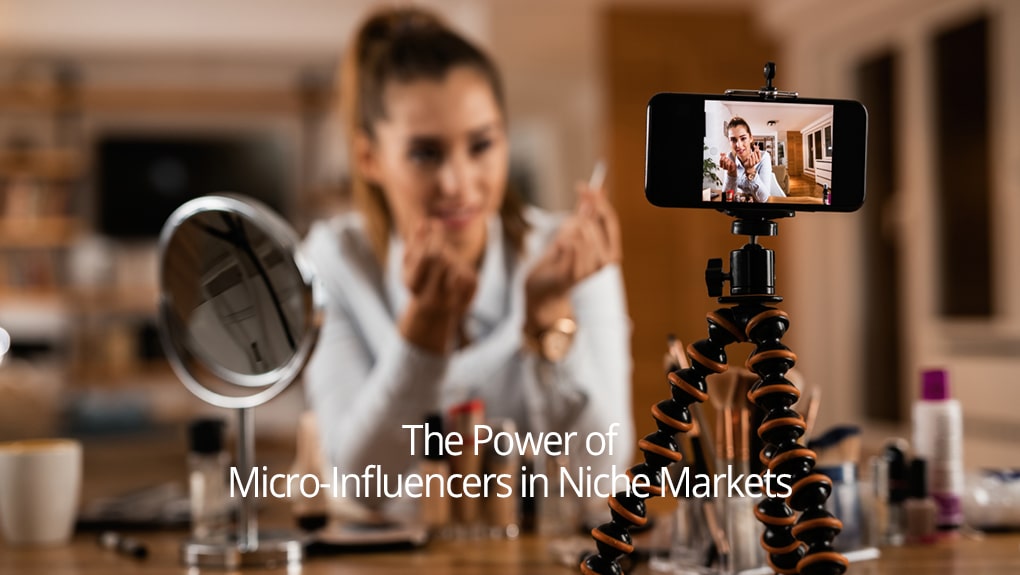|
Getting your Trinity Audio player ready...
|

Within the ever-evolving realm of digital marketing, the role of influencers has evolved significantly. While mega-influencers and celebrities have dominated the scene for years, a new class of influencers is emerging, gaining traction and proving to be incredibly effective for brands. These are the micro-influencers—individuals who have a smaller but highly engaged following. This article delves into the growing influence of micro-influencers in niche markets and explores how brands can harness their power for targeted marketing.
The Rise of Micro-Influencers
Micro-influencers typically have between 1,000 to 100,000 followers on social media platforms. Unlike their larger counterparts, they often focus on specific niches, ranging from fitness and beauty to travel and technology. The appeal of micro-influencers lies in their authenticity and the trust they build with their audience. As they are perceived as more relatable and genuine, their recommendations carry significant weight, leading to higher engagement rates.
Authenticity and Trust
In an age where consumers are becoming increasingly skeptical of traditional advertising, authenticity is paramount. Micro-influencers excel in this area because they are often viewed as everyday people who share real experiences and honest opinions. Their content is seen as more organic and less commercial, fostering a deeper connection with their followers.
This authenticity translates into trust, a critical factor in influencing purchasing decisions. According to a study by Nielsen, 92% of consumers trust recommendations from individuals over brands. Micro-influencers, with their perceived sincerity, are well-positioned to leverage this trust, making their endorsements more impactful.
Higher Engagement Rates
Engagement rate is a crucial metric in influencer marketing, and micro-influencers often outperform their larger counterparts in this regard. A study by Markerly found that as the number of followers increases, the engagement rate tends to decrease. Micro-influencers, with their smaller but more dedicated following, achieve higher engagement rates, meaning their audience is more likely to interact with their content through likes, comments, and shares.
This heightened engagement is invaluable for brands, as it indicates a more active and interested audience. When micro-influencers endorse a product or service, their followers are more likely to take notice and act on the recommendation.
Micro-Influencers in Niche Markets
Niche markets are specific, well-defined segments of the market with distinct needs and preferences. They can range from vegan skincare enthusiasts to vintage car collectors. Micro-influencers thrive in these niches because of their specialized knowledge and passion for the subject matter. Their ability to speak directly to the interests and concerns of their audience makes them powerful advocates for brands operating within these niches.
Deep Connection with the Audience
Micro-influencers in niche markets often share a genuine passion for their subject matter, which resonates with their audience. This shared interest fosters a sense of community and loyalty, as followers feel that the influencer truly understands their needs and preferences. This deep connection enhances the influencer’s credibility and makes their recommendations more persuasive.
Expertise and Credibility
Niche micro-influencers are often seen as experts in their field. Whether it’s a tech enthusiast reviewing the latest gadgets or a fitness trainer sharing workout tips, their expertise lends credibility to their content. Brands can leverage this expertise to enhance their own credibility and reach a highly targeted audience with a genuine interest in their products or services.
Tailored Content
Micro-influencers create content that is highly tailored to their niche audience. This specificity allows brands to reach consumers with highly relevant messages. For example, a micro-influencer in the vegan cooking niche can create content showcasing a brand’s plant-based products in a way that is both engaging and informative to their audience. This tailored approach is more likely to resonate with consumers than generic advertising.
Collaborating with Micro-Influencers
Brands can greatly benefit from collaborating with micro-influencers, but it requires a strategic approach. Here are some key steps to effectively engage with micro-influencers:
Identifying the Right Influencers
The first step is to identify micro-influencers who align with the brand’s values and target audience. Tools like BuzzSumo, Upfluence, and SocialBakers can help brands discover influencers based on specific keywords, topics, and engagement metrics. It’s essential to look beyond follower count and assess the influencer’s engagement rate, content quality, and audience demographics.
Building Genuine Relationships
Successful collaborations are built on genuine relationships. Brands should take the time to engage with potential influencers by following their social media profiles, liking and commenting on their posts, and sharing their content. This initial engagement helps establish a connection and demonstrates that the brand values the influencer’s work.
Clear and Transparent Communication
Once a collaboration is initiated, clear and transparent communication is vital. Brands should articulate their goals, expectations, and any specific requirements for the partnership. It’s also important to give influencers creative freedom to maintain the authenticity of their content. Overly controlling the message can backfire, leading to content that feels forced and insincere.
Compensation and Incentives
While some micro-influencers may be willing to collaborate in exchange for free products, it’s important to offer fair compensation for their work. This not only shows respect for their time and effort but also helps build a positive and long-lasting relationship. Compensation can be monetary or in the form of exclusive experiences, product previews, or other incentives.
Measuring Success
To evaluate the effectiveness of a micro-influencer campaign, brands should establish clear metrics for success. These can include engagement rates, reach, website traffic, and conversions. Tools like Google Analytics, social media analytics, and influencer marketing platforms can provide valuable insights into the campaign’s performance. Regularly reviewing these metrics helps refine future strategies and optimize results.
Case Studies: Brands Successfully Leveraging Micro-Influencers
Glossier
Glossier, a beauty brand known for its minimalist and user-friendly products, has effectively harnessed the power of micro-influencers. Instead of relying on traditional advertising, Glossier collaborates with everyday customers and beauty enthusiasts who share their experiences and product reviews on social media. This approach has helped Glossier build a loyal community and generate significant buzz around its products.
Daniel Wellington
Daniel Wellington, a Swedish watch brand, has successfully utilized micro-influencers to expand its global reach. By partnering with a diverse range of influencers across various niches, Daniel Wellington has created a strong online presence and cultivated a stylish and aspirational brand image. These collaborations often involve unique discount codes and giveaways, driving both engagement and sales.
MVMT
MVMT, a direct-to-consumer watch and accessories brand, has leveraged micro-influencers to drive brand awareness and sales. By partnering with influencers in fashion, travel, and lifestyle niches, MVMT has been able to reach a highly targeted audience. The brand’s influencer marketing strategy includes a mix of sponsored posts, affiliate marketing, and user-generated content, all of which contribute to a cohesive and authentic brand narrative.
The Future of Micro-Influencer Marketing
As the digital marketing landscape continues to evolve, the role of micro-influencers is likely to grow even more prominent. Here are some trends and predictions for the future of micro-influencer marketing:
Increased Investment
Brands are expected to allocate more of their marketing budgets to micro-influencer collaborations. The high engagement rates and targeted reach offered by micro-influencers make them an attractive option for brands looking to maximize their return on investment. As more brands recognize the value of micro-influencers, competition for partnerships may increase, leading to higher compensation and more innovative collaboration strategies.
Diversification of Platforms
While Instagram remains a popular platform for influencer marketing, other platforms like TikTok, YouTube, and LinkedIn are gaining traction. Brands will need to diversify their influencer marketing efforts across multiple platforms to reach different segments of their target audience. This diversification also allows brands to experiment with various content formats, such as short-form videos, live streams, and long-form articles.
Emphasis on Long-Term Relationships
Rather than one-off campaigns, brands will focus on building long-term relationships with micro-influencers. These sustained partnerships allow for deeper collaboration, more authentic content, and a stronger connection with the audience. Long-term relationships also enable influencers to develop a more comprehensive understanding of the brand, leading to more effective and impactful promotions.
Enhanced Measurement and Analytics
Advancements in analytics tools will provide brands with deeper insights into the performance of their influencer marketing campaigns. This includes more sophisticated tracking of engagement, reach, conversions, and return on investment. Enhanced measurement capabilities will help brands optimize their strategies and make data-driven decisions for future campaigns.
Focus on Inclusivity and Diversity
As consumers increasingly demand inclusivity and diversity in marketing, brands will need to ensure their influencer partnerships reflect these values. Collaborating with a diverse range of micro-influencers helps brands connect with a broader audience and demonstrate their commitment to representation and inclusivity.
Logical Conclusion
The power of micro-influencers in niche markets cannot be overstated. Their authenticity, trustworthiness, and deep connection with their audience make them invaluable partners for brands seeking to engage with specific segments of the market. By identifying the right influencers, building genuine relationships, and leveraging their expertise, brands can create highly effective and targeted marketing campaigns.
As the digital landscape continues to evolve, micro-influencers will play an increasingly important role in shaping consumer behavior and driving brand success. By staying ahead of trends and continually refining their strategies, brands can harness the full potential of micro-influencer marketing and achieve meaningful and lasting results.




